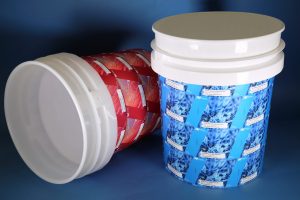
StackTeck optimizes TRIM pail design to pass UN test standards
Canadian Plastics
Canadian Plastics Packaging Research & DevelopmentThe pails are eight per cent lighter than a benchmarked industry standard five-gallon pail, while meeting UN standards 7.4 (drop test) and 7.5 (compression test).

Photo Credit: StackTeck Systems Ltd.
Brampton, Ont.-based moldmaker StackTeck Systems Ltd. has successfully optimized the design of a TRIM five-gallon pail to pass UN standards.
In a July 15 news release, Stackteck officials described the development as “another step in offering sustainable solutions to the consumer markets that are looking for part weight reductions while being fully compliant with UN test standards for drop tests and compression.”
The optimized TRIM pails are eight per cent lighter than a benchmarked industry standard five-gallon pail, while meeting UN standards 7.4 (drop test) and 7.5 (compression test).
“We did structural filling analysis to ensure top load strength and survival of drop tests,” said engineering director Jeff Ngai. “From the simulations that we ran, we identified that there is a big reduction in the strength and performance of the part when we had thinned out portions closer to the bottom corner of the pail. We then evolved the design to remove the TRIM patterns from the lower portion of the part while maintaining the light weight in the remaining areas of the pail which did not affect structural strength. This is a great milestone for us to have achieved in times like this when there is a substantial demand for more sustainable packaging solutions.”
StackTeck has built a demonstration pail mold with two cores, so the mold can switch back and forth between the optimized TRIM design, and a conventional version of the same pail with a uniform 0.090-inch wall thickness. According to Jordan Robertson, vice president of business development and marketing, “The demonstration pail mold was configured to show the differences in pail strength between conventional and TRIM pails. We also incorporated features to enhance mold cooling using our KoolTrack mold designs and special alloys, to demonstrate a cycle time difference. For the wall thicknesses in the conventional pail, we know it typically runs at 16-18 seconds cycle time, and when we put the KoolTrack components in the mold we were able to run good parts at 13 seconds.”
